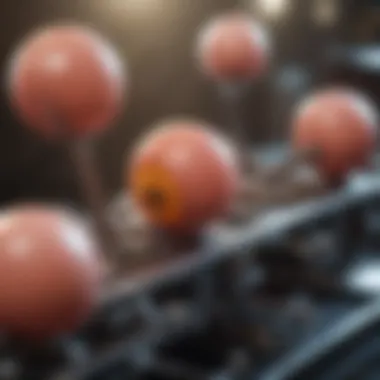Colchicine: Mechanisms and Clinical Applications


Intro
Colchicine has carved a niche in the realm of medicine, known for its unique properties and historical significance. Historically employed by ancient civilizations, its journey has evolved, leading it to contemporary applications in treating various inflammatory disorders. The intricate science behind colchicine’s effectiveness, particularly in conditions like gout and familial Mediterranean fever, unveils a tapestry of pharmacological interactions.
As we peer into its mechanisms, we observe how this humble plant-derived molecule alters pathways of inflammation, mitigating the body’s response to pain and swelling. The diverse applications make it a subject of intense study, prompting researchers and practitioners alike to explore its full potential.
In the following sections, we will embark on a comprehensive exploration, illuminating the mechanisms by which colchicine operates, its clinical uses, and considerations surrounding its safety and efficacy.
Understanding Colchicine
Colchicine stands as a significant element in the field of medicine, especially for its role in treating various inflammatory conditions. Understanding its historical background and sources is crucial, not just from a scientific perspective, but also for its implications in clinical practices today. The multifaceted mechanisms of colchicine, along with its diverse applications, depict why it remains relevant for healthcare providers and researchers alike. This section is essential as it lays the groundwork for grasping the nuances of potential therapeutic benefits, while also considering safety and efficacy in its usage.
Historical Background
Colchicine's journey through history is both rich and remarkable. Originally sourced from the autumn crocus flower, Colchicum autumnale, its medicinal properties have been recognized for centuries. Ancient texts suggest that the ancient Greeks utilized this plant to treat various ailments, particularly those associated with arthritis. Fast forward to the 19th century, the active compound was isolated, and scientists began understanding how it affected cellular processes.
It's fascinating to explore how colchicine was once a folk remedy, used in an empirical manner, before rigorous scientific study validated its utility. For instance, during the early expeditions into pharmacology, practitioners relied on trial and error, often combining herbal remedies with limited knowledge of anatomy and physiology. Colchicine managed to survive the transitions of ancient medicine into contemporary therapies, showcasing not only its effectiveness but also its ability to adapt to modern scientific advancements.
Sources of Colchicine
Colchicine is primarily derived from the seeds and bulbs of the plant species Colchicum autumnale, which is widely distributed across Europe and parts of Asia. While the plant is the traditional source, modern synthesis methods have emerged, allowing for the creation of this compound in laboratory settings. This is particularly important as it ensures reliable production and consistent quality for pharmaceutical use.
Beyond the natural extraction, the delineation of its sources encompasses a broader understanding of its biological effects. Here are some notable aspects regarding sources:
- Plant-Based Source: Colchicum autumnale contains the highest concentrations of colchicine, particularly in its seeds. This highlights the importance of harvesting practices in maintaining biodiversity and sustainability.
- Synthetic Pathways: The development of synthetic alternatives to natural colchicine aids in circumventing issues related to plant toxicity and ecological regulation. This opens avenues for large-scale production without the environmental footprint of foraging.
- Formulations: Colchicine is commonly available in various formulations such as tablets or injectable forms, catering to different patient needs and clinical scenarios.
"The journey of colchicine from ancient folk remedy to a mainstay in the treatment of gout and other inflammatory diseases illustrates the power of natural substances transformed by science."
Pharmacodynamics of Colchicine
Understanding the pharmacodynamics of colchicine is crucial for deciphering its therapeutic role. This topic explores how the drug interacts within the body to exert its effects. It sets the stage for practitioners to make informed decisions on its application in various medical conditions.
Mechanisms of Action
Colchicine operates primarily by affecting microtubule polymerization. By inhibiting this process, it disrupts the assembly of microtubules, which are essential for cell division and movement. This action plays a pivotal role in reducing inflammation, particularly in conditions like gout.
The drug is known to modulate the immune response, which contributes to its overall effectiveness. For instance, by inhibiting chemotaxis, colchicine limits the migration of leukocytes to sites of inflammation. This helps reduce pain and swelling experienced by patients during gout attacks. Beyond gout, this mechanism is also relevant in treating familial Mediterranean fever and other inflammatory diseases. Ultimately, colchicine's action at the cellular level is central to its ability to modulate inflammatory processes.
Absorption and Distribution
When it comes to absorption, colchicine is rapidly absorbed from the gastrointestinal tract. Peak plasma concentrations usually occur within a couple of hours post-administration. However, the bioavailability is not absolute, as factors such as food intake can influence absorption rates, often decreasing peak plasma levels.
Distribution is also noteworthy. Colchicine has a broad distribution volume, indicating that it permeates into various tissues. It binds significantly to blood cells, which suggests that its action may involve multiple tissue interactions rather than being limited to the bloodstream. Interestingly, the uptake in certain tissues also underscores its potential effects and highlights considerations in dosing.
Metabolism and Excretion
The liver plays a key role in metabolizing colchicine through a process known as biotransformation. It’s predominantly metabolized by the cytochrome P450 system, which transforms the parent compound into various metabolites. Notably, these metabolites have their own unique interactions and effects in the body, contributing to the drug's overall profile.
Excretion primarily occurs via the kidneys. A significant portion of the drug, together with its metabolites, is excreted in the urine. This is particularly pertinent when managing dosing in patients with renal impairment. Understanding the metabolism and excretion pathways of colchicine aids clinicians in modifying treatment strategies, ensuring efficacy while minimizing adverse effects.
"The pharmacodynamics of colchicine not only helps in treating symptoms but also in shaping the treatment approach based on underlying mechanisms."
In summary, the pharmacodynamics of colchicine provides essential insights into its modes of action, absorption characteristics, and metabolic pathways. Such knowledge is indispensable for optimizing its use in clinical settings, allowing healthcare professionals to benefit from this ancient yet valuable therapeutic agent.


Clinical Applications
The clinical applications of colchicine are significant, reflecting both its historical roots and its evolving role in modern medicine. Known primarily for its use in managing gout, colchicine's therapeutic benefits extend beyond a single condition. The ongoing research into its effects on various inflammatory diseases showcases the versatility of this ancient drug. Understanding these applications is essential for practitioners, as it presents a comprehensive view of how colchicine can be effectively integrated into treatment plans for diverse patient populations.
Use in Gout Management
Gout, characterized by sudden and severe pain, swelling, and redness in the joints, particularly the big toe, is primarily caused by hyperuricemia, which leads to the deposition of urate crystals. Colchicine has been a cornerstone in gout management for decades. Its mechanisms of action include disrupting the inflammatory response triggered by the crystals, ultimately alleviating pain and reducing inflammation.
Practitioners often prescribe colchicine for both acute attacks and prophylactic therapy. An important consideration is the timing of administration; starting treatment early in an attack tends to yield the best results. Here are some nuances of its use in gout management:
- Efficacy: Colchicine is effective when administered within the first 12-24 hours of a gout flare.
- Dosing: Initial dosing typically involves loading doses, followed by lower maintenance to prevent future flares.
- Patient Education: It's crucial for patients to understand the potential side effects, which can include gastrointestinal upset. Adhering to guidelines on dosing can help mitigate these effects and empower patients in their treatment journey.
Familial Mediterranean Fever
Familial Mediterranean Fever (FMF) is another area where colchicine has shown considerable efficacy. This hereditary inflammatory disorder primarily affects individuals of Mediterranean descent and is characterized by recurrent episodes of fever and painful inflammation in the abdomen, chest, and joints. Colchicine is considered the first-line treatment for FMF.
The benefits of colchicine treatment in FMF include:
- Reducing Attacks: Regular colchicine use can significantly decrease the frequency and severity of inflammatory attacks.
- Preventing Complications: Long-term treatment helps prevent serious complications, such as amyloidosis, which can arise from chronic inflammation.
- Safety Profile: The safety profile of colchicine makes it suitable for long-term use, although monitoring of side effects is still necessary.
Other Inflammatory Conditions
Beyond gout and FMF, colchicine is being explored for its effects on a variety of other inflammatory conditions, showcasing its broad therapeutic potential.
Some of these conditions include:
- Pericarditis: Colchicine has been shown to reduce the recurrence of pericarditis, an inflammation of the heart's outer lining, after an initial episode.
- Psoriasis: There is emerging evidence to suggest that colchicine may have a role in treating psoriasis, possibly by modulating inflammatory pathways.
- COVID-19: Recent research has indicated that colchicine could potentially mitigate the inflammatory response in COVID-19 patients, pointing to its role in addressing conditions characterized by excessive inflammation.
"Colchicine's unique ability to address inflammation makes it a candidate for broader therapeutic applications beyond its traditional uses."
In summation, while colchicine is primarily hailed for its role in gout and FMF, ongoing research continues to unveil its potential applications across various inflammatory disorders. Healthcare professionals should remain informed on these developments to harness the full therapeutic potential of colchicine in their clinical practice.
Dosage and Administration
The dosage and administration of colchicine are critical components of its therapeutic application. Understanding the right dosages and the ways to administer this medication ensures both efficacy and safety. Lack of adherence to proper guidelines can lead to suboptimal outcomes or serious adverse effects. Hence, discussing these guidelines should illuminate the judicious use of colchicine, especially in its most common applications.
Standard Dosage Guidelines
When considering the standard dosages of colchicine, it's vital to note that these can vary based on the specific condition being treated. Colchicine is often introduced in a loading dose followed by a maintenance regimen.
- Gout treatment typically starts with an initial dose ranging from 1.2 mg to 1.8 mg for an acute gout flare, followed by 0.6 mg one hour later and then reduced to a maintenance dose of 0.6 mg once or twice daily.
- For familial Mediterranean fever, the usual dosage is lower, often around 1–2 mg daily, tailored to the severity and frequency of attacks.
It's wise for clinicians to regularly evaluate their patients and adjust the doses based on response and tolerance. Often, oral administration is most common, but in extreme circumstances, healthcare providers might go for alternative routes.
"Proper dosing maximizes the benefits of colchicine and minimizes its risks."
Administration Routes
Colchicine is primarily administered orally, but knowing about other routes can be quite important. Administration may follow different routes based on patient needs and clinical circumstances.
- Oral tablets: This is the mainstay for most patients. It's easy to take and offers a straightforward approach in outpatient settings.
- Intravenous (IV) route: Though infrequently used, this method can be applied in emergency situations, particularly when rapid action is demanded or the patient is unable to take oral medications. It's essential that this is done under strict medical supervision as the risks can increase significantly in IV application.
Keep in mind that when switching from one route to another, careful monitoring is advisable. Adjustments in dosage may be required to account for bioavailability differences.


In summary, the effective use of colchicine hinges upon understanding its dosing framework and administration techniques. A well-informed approach can prevent potential complications while maximizing therapeutic benefits.
Side Effects and Contraindications
Understanding the side effects and contraindications of colchicine is critical for ensuring patient safety and optimizing therapeutic outcomes. While this medication has proven benefits, it also carries its share of risks. Recognizing these potential adverse effects allows healthcare providers to make informed decisions in prescribing colchicine, particularly in populations with specific health conditions. The details outlined in this section aim to enlighten practitioners on what to watch for and how to mitigate risks associated with colchicine therapy.
Common Adverse Effects
Colchicine is generally well-tolerated, but patients can experience a range of mild to moderate side effects. Some common adverse effects include:
- Gastrointestinal Symptoms: Many patients may encounter nausea, vomiting, or diarrhea. These symptoms are often dose-dependent and can be particularly troublesome if colchicine is administered in high doses.
- Abdominal Pain: Cramping or pain in the abdominal region is another frequent report among users.
- Fatigue: A feeling of tiredness or weakness can accompany colchicine therapy for some patients.
- Headaches: This is also a notable adverse effect reported during treatment.
These adverse effects, while uncomfortable, tend to resolve once the medication is discontinued or the dose is adjusted. It's essential for clinicians to communicate these possibilities to patients to help manage expectations and encourage them to report any discomfort.
Severe Reactions
Though rare, colchicine can lead to severe reactions that require immediate medical attention. These include:
- Bone Marrow Suppression: This serious condition may manifest as unexplained bleeding, bruising, or frequent infections due to a drop in blood cell production.
- Rhabdomyolysis: This condition, characterized by muscle breakdown, can occur, especially when colchicine is used in conjunction with other medications that impact muscle health.
- Acute Renal Failure: Elevated levels of colchicine can lead to kidney dysfunction, particularly in patients with pre-existing conditions or those taking nephrotoxic drugs.
- Severe Allergic Reactions: Though uncommon, reactions such as swelling, hives, or difficulty breathing can occur and warrant urgent care.
Patients experiencing these severe reactions should cease use of the medication and seek medical advice immediately. Early intervention is key to preventing serious complications.
Contraindications
Certain populations should avoid colchicine due to the increased risk of severe adverse effects. These contraindications include:
- Pregnant Women: Colchicine can have harmful effects on fetal development, so it's generally contraindicated during pregnancy.
- Patients with Severe Kidney or Liver Dysfunction: Those with compromised renal or hepatic function are at increased risk of toxicity and serious side effects, thus necessitating careful consideration before prescribing.
- Individuals with Delayed Gastric Emptying: Given the potential for gastrointestinal issues, those with this condition may not tolerate colchicine well.
- Known Allergies: Patients with a known hypersensitivity to colchicine should not use this medication, as they risk exacerbating allergic symptoms.
Always evaluate the full medical history of a patient before prescribing colchicine to ensure safety and effectiveness.
Colchicine in Current Research
The evolving landscape of research surrounding colchicine sheds light on its multifaceted roles beyond its established applications. As we plow deeper into the science behind colchicine, it becomes evident that this ancient medication holds promise in various modern therapeutic contexts. The current research not only seeks to validate existing knowledge but also aims to explore novel avenues of treatment that could harness the unique mechanisms of colchicine. Understanding these ongoing investigations can facilitate better treatment strategies, particularly for those grappling with chronic inflammatory conditions or unique pathologies.
Recent Clinical Trials
Recent clinical trials have taken a fresh look at colchicine, investigating its efficacy in conditions beyond its traditional scope. A notable study published in the New England Journal of Medicine examined colchicine's role in preventing cardiovascular events among patients with a history of myocardial infarction. The trial concluded that the medication could potentially reduce the incidence of recurrent heart attacks through its anti-inflammatory properties. This is particularly significant since heart disease remains a leading cause of morbidity and mortality worldwide.
Furthermore, ongoing research is looking into using colchicine for various autoimmune diseases. In a multi-center trial, researchers are exploring its effectiveness in rheumatoid arthritis management, specifically focusing on how it interacts with other systemic therapies to reduce flares and manage symptoms more effectively. The preliminary results indicate promise, but researchers stress the necessity of larger sample sizes to draw definitive conclusions.
Other trials have delved into its application in gastrointestinal diseases, particularly examining its potential for managing symptoms of inflammatory bowel diseases like Crohn’s disease. The anti-inflammatory action of colchicine seems to offer a novel approach in a domain where treatment options can be limited and patient responses varied.
In summary, recent clinical trials are broadening our understanding of colchicine's therapeutic potential. With innovative designs and comprehensive methodologies, these studies could pave the way for switching colchicine from a historical remedy to a mainstay in modern therapeutic regimens.
Investigational Uses
Colchicine’s investigational uses extend into a myriad of conditions, reflecting its versatility as an agent in the medicinal toolkit. Researchers are delving into applications that have yet to be fully explored in clinical practice.
One prominent area of interest is the effects of colchicine on respiratory diseases. Studies have begun to reveal how it might influence chronic obstructive pulmonary disease (COPD) symptoms. By modulating inflammatory responses in the lungs, colchicine may offer a new avenue for alleviating some of the chronic inflammation seen in these patients. Initial findings suggest that this treatment could be a novel adjunct in a regimen typically dominated by bronchodilators and corticosteroids.
In addition to respiratory diseases, the role of colchicine in oncology is being scrutinized. There’s a burgeoning narrative surrounding its potential to inhibit tumor growth and augment cancer treatment protocols, particularly through its cytotoxic properties. Some preclinical studies suggest its combination with existing chemotherapeutics may enhance treatment efficacy, especially in cancers known for their inflammatory components.
Lastly, there are efforts to assess colchicine's potential in mitigating complications associated with COVID-19. Some clinical trials are focusing on its ability to diminish the cytokine storm, which has emerged as a critical issue in severe cases of the virus. By controlling inflammation, colchicine may help stabilize patients and potentially decrease hospitalization durations, although these findings need further examination through robust trial frameworks.


As researchers continue to unravel the complexities of this medication, it’s apparent that colchicine has more to offer than previously recognized, and ongoing studies are critical in discovering its full potential for diverse medical applications.
Comparative Analysis with Other Treatments
In discussing colchicine, it's essential to place it in the context of other treatment options available for managing inflammatory conditions. The comparative analysis serves several important roles. First, it helps healthcare providers make informed decisions based on efficacy, safety, and patient-specific considerations. Second, it highlights the unique position of colchicine within the therapeutic landscape, especially regarding its specific actions that set it apart from standard treatments.
Understanding how colchicine stacks up against its competitors not only facilitates optimal patient care but also opens the door to exploring novel combination strategies which might enhance treatment outcomes. Here, we delve into two key comparisons: colchicine versus non-steroidal anti-inflammatory drugs (NSAIDs) and its role in combination therapies.
Colchicine Versus Non-Steroidal Antiinflammatories
When you lay colchicine alongside NSAIDs, you're looking at two distinct strategies for managing inflammation and pain.
- Mechanism of Action: Colchicine primarily exerts its effects through inhibition of microtubule formation, which disrupts inflammatory cell migration and the release of inflammatory mediators. NSAIDs, on the other hand, primarily block the cyclooxygenase enzymes (COX-1 and COX-2), which play a crucial role in prostaglandin synthesis.
- Efficacy in Gout: In managing acute gout flares, research has consistently pointed toward colchicine as equally effective as NSAIDs, but with a lower incidence of gastrointestinal side effects when administered in lower doses. However, the onset of action may vary, as NSAIDs often provide faster relief, but the duration of effect from colchicine can be more sustained in certain patients.
- Safety Profiles: It’s crucial to assess the safety profiles of both treatments. NSAIDs can lead to a host of issues like gastrointestinal irritation, renal impairment, and cardiovascular risks, particularly with chronic use. Colchicine, while generally considered safe within its therapeutic window, does have risks associated with overdosing. The crux lies in provider's assessments of individual patient histories and potential contraindications.
"Choosing between colchicine and NSAIDs isn't just about looking at the medications themselves but understanding the broader clinical picture of the patient."
Colchicine in Combination Therapies
Moving forward to combination therapies, colchicine's role becomes even more intriguing. Combining drugs can be beneficial, particularly in cases of resistant conditions or where single-agent therapies don’t suffice. Here are some points worth considering:
- Synergistic Effects: Combining colchicine with other agents, such as corticosteroids or NSAIDs, may enhance anti-inflammatory effects, especially in managing acute exacerbations of gout. This synergistic action could potentially enable lower dosages of each agent, thereby reducing adverse effects while maintaining efficacy.
- Individualized Therapy: Not every patient responds the same way to medications. Knowledge of how colchicine interacts with other medications informs personalized treatment plans. For instance, in patients with severe chronic inflammatory diseases, integrating colchicine with disease-modifying antirheumatic drugs could yield more favorable outcomes.
- Research Insights: Current studies are exploring colchicine in different combinations, including cardiovascular treatments, especially regarding its anti-inflammatory properties. The ongoing research indicates potential applicability beyond gout and familial Mediterranean fever.
In summary, comparative analysis of colchicine with other treatments provides valuable insights into its use and benefits. Understanding not only the standalone efficacy but also its role in partnerships with other agents further strengthens the therapeutic armamentarium available to clinicians. This knowledge ensures that patients receive the most appropriate and effective care tailored to their unique needs.
Patient Considerations
Patient considerations play a fundamental role in the effective use of colchicine, especially given its historical context and the broad spectrum of its clinical applications. It's not merely about prescribing the medication; it’s about understanding the patient holistically. By focusing on this topic, healthcare providers can ensure they are not just treating symptoms but are also addressing the individual needs and circumstances of each patient. This approach can lead to improved adherence to treatment, better clinical outcomes, and heightened patient satisfaction over time.
Monitoring and Follow-Up
Regular monitoring and follow-up are crucial in managing patients on colchicine therapy. Colchicine can have significant effects on the body, particularly those related to liver and kidney function. Therefore, ensuring that patients are regularly assessed helps identify any adverse effects early and allows for timely intervention.
- Routine Blood Tests: Periodic blood evaluations should be performed to check liver enzymes and kidney function. This is especially important for older adults or those with preexisting conditions that may impact organ function.
- Symptom Tracking: Patients should be encouraged to keep a log of their symptoms and any side effects they experience. This personal diary can aid healthcare professionals in making informed decisions about continuing or adjusting the dosage.
- Discussing Changes in Health Status: Patients often experience other health issues over time. It's essential for them to communicate any new health concerns or changes in medication that may affect their colchicine treatment. For instance, discussing the use of over-the-counter drugs or supplements is vital, as some could interact negatively with colchicine.
"Patients need to feel they can report anything that seems unusual. Open communication can significantly enhance their safety while on this medication."
Educating Patients
Education serves a pivotal role in fostering a comprehensive understanding of colchicine among patients. Many individuals might not grasp the full implications of the treatment they are undergoing. By providing detailed information, healthcare providers can empower patients to take an active role in their health management.
- Mechanism of Action: Patients should understand how colchicine works. Future discussions could revolve around its ability to prevent inflammatory processes by inhibiting certain immune responses. This knowledge can reassure patients about why they are taking the medication.
- Side Effects: It's vital to outline potential side effects, like gastrointestinal discomfort or, in rare cases, more severe reactions. When patients are forewarned, they are better prepared to identify these issues quickly and seek help if necessary.
- Lifestyle Factors: Beyond medication, lifestyle factors such as diet, exercise, and hydration play a role in how effectively colchicine works. Patient education should include tips on how to make these changes to complement their treatment.
- Adherence Strategies: Patients should be educated about the importance of sticking to the prescribed regimen. Simple strategies, such as setting reminders or using a pill organizer, can be shared to encourage adherence and avoid missed doses.
Ending and Future Directions
The exploration of colchicine transcends its historical roots and entrenched use in treating specific inflammatory conditions. It illustrates how ancient remedies can still bear significant relevance in contemporary medicine. Understanding the mechanisms and applications of colchicine enhances our grasp of its clinical value today. This section highlights the importance of continuing research into colchicine's efficacy and potential new uses.
Summarizing Key Points
We’ve traversed the landscape of colchicine—from its ancient roots to its nuanced mechanisms of action. Here’s a brief recap of key points:
- Mechanisms of Action: Colchicine does not merely alleviate symptoms; it interferes with the inflammatory process at multiple stages. This includes disrupting microtubule formation, which is vital for inflammatory cell migration.
- Clinical Uses: Its primary role remains in the management of gout and familial Mediterranean fever. However, new evidence suggests applications in other inflammatory diseases, indicating a broader therapeutic landscape.
- Safety and Efficacy: While generally safe, it is essential to monitor patients receiving colchicine due to potential side effects. This highlights the importance of patient education and regular follow-ups.
In short, colchicine is more than a historical treatment; it is an evolving subject of study with significant implications for various patient populations.
"Colchicine's adaptability in medicine showcases how old-world knowledge can mesh with modern practices to serve patients effectively."
Potential for New Developments
Looking to the future, there’s a whisper of possibility surrounding colchicine. Clinical trials are already exploring its versatility beyond traditional applications. For instance, investigations have reported interest in using colchicine for cardiovascular diseases, reflecting a growing understanding of inflammation's role in heart health. Research holds the potential to unlock novel mechanisms, leading to new formulations or combination therapies that can enhance its efficacy while minimizing adverse effects.
Given its well-established pharmacological profile, the pathway for finding new indications appears promising. Moreover, the integration of precision medicine principles might streamline colchicine therapy for tailored patient care in inflammatory diseases.
In summary, the discussion on colchicine is not just an end, but rather a foundation for ongoing inquiry and innovation. Practitioners and researchers must continue to engage with this medication to fully uncover its potential.
As the landscape of medical research unfolds, colchicine remains a cornerstone from which new therapeutic horizons can emerge.





